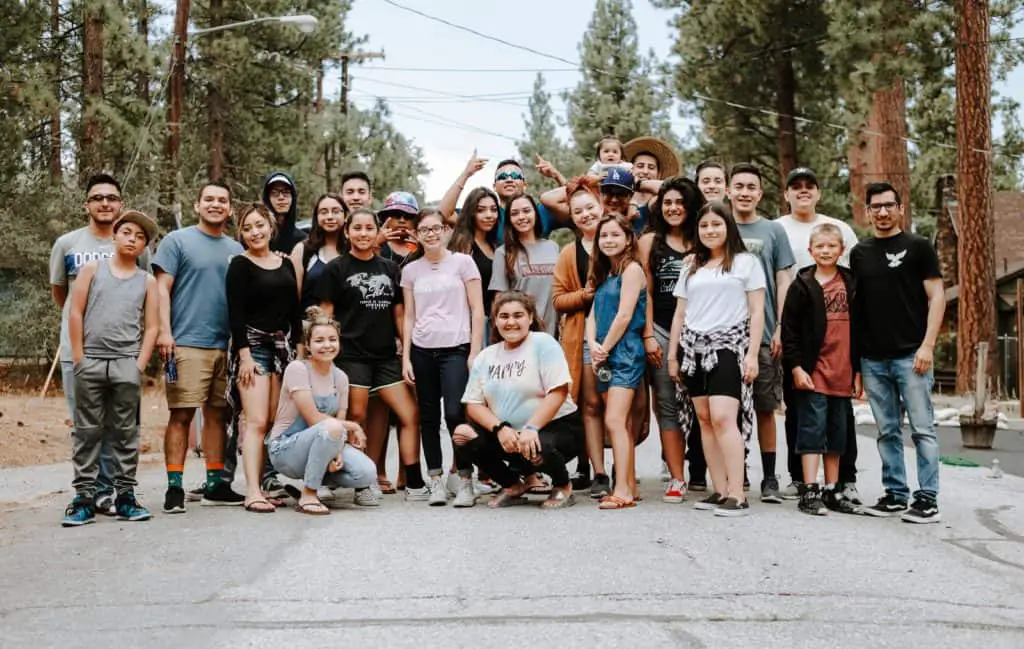The digital nomad trend is growing. Once considered an ambitious dream, this lifestyle is becoming more and more achievable thanks to the recent advances in connective technology, remote work, and workplace culture.
In this report we will explore:
- Who are digital nomads
- What they do
- Where they go
- Pros and cons of the lifestyle
- How much they earn
- How COVID-19 has affected the industry
- Forecast and future trends
- Biggest communities
- Visa and governmental initiatives
- Coworking & coliving initiatives and other opportunities
[Bonus] Infographic
If you’re more of a visual person, we’ve created a nice infographic of the 2021 digital nomad statistics. Feel free to save it on your computer and share it with others.
Section One: Who Are Digital Nomads?

When hearing the word “digital nomad”, it is easy to imagine young, hip surfers typing away on their laptops in exotic destinations. The reality, though, is a bit more nuanced than that.
In this section we will explore:
- Digital nomad demographics and generations
- Digital nomads’ family life
- The different approaches to digital nomadism
- Where digital nomads stay
By “digital nomad” we refer to people who rely on connective technology to make a living and opt for a nomadic lifestyle. Usually employed or self-employed in their country of origin, these workers can do their job on their laptops from anywhere with good internet access.
This broad community is composed of self-reliant and highly driven individuals with a burning desire to be location and financially independent.
Despite a strong common denominator, digital nomads are a very heterogeneous group of individuals from all walks of life.
Digital nomad demographics and generations
According to data from a FlexJob survey:
- 27% of digital nomads identify as millennials or gen Z
- 41% identify as gen X
- 32% identify as baby boomers
Surprisingly enough, the average digital nomad’s profile defies the 20-something male stereotype. In fact, over the last couple of year, DN’s appear to be:
- 70% female
- 30% male
In the US alone, the racial makeup of digital nomads looks as follow:
- 70% of respondents identify as white
- 14% of respondents identify as African American
- 7% identify as Hispanic
- 7% of respondents identify as Asian, and
- 2% percent identify as being from another background.
Interestingly enough, these numbers have been consistent year-over-year.
Family life
- 61% of digital nomads are married and 39% are single or divorced
- 31% of married nomads travel with their spouses full-time. 38% travel with them part-time. 32% don’t travel with their partners.
- 26% of digital nomads have children aged 18 and under. Of those with children:
- 41% say their children travel with them
- 59% say their children don’t travel with them
The different approaches to digital nomadism
Said differences are also identifiable in the various travel styles and preferences:
- The Wanderluster: Constantly on the move, this type of digital nomad is usually young and will only stay put anything between 1-3 months
- The Slow Nomad: As the name indicates, this nomad opts for a less frantic lifestyle, remaining in the same place for anywhere between 3-6 months
- The Travel-lover: Not everyone who chooses to work remotely and loves exploring feels the need to be constantly on the move. The travel-lover will usually have a “home base” to return to and will enjoy the benefits of traveling any time of the year without necessarily taking time off work.
- The Expat: The quintessential “slow traveler”, this nomad will choose to live in one country for a year or longer, truly immersing themselves in everything the place has to offer
According to the FlexJob survey:
- 65% of digital nomads have spent a maximum of 1-3 consecutive months traveling
- 14% have traveled 3-6 consecutive months
- 10% have traveled 6 months to 1 year
- Finally, 11% state they have traveled for 1+ year
Of these:
- 22% stay 1-2 weeks in one location before moving on to the next
- 17% spend less than a week at the same location
- 12% will spend between 3-4 months
- 11% will stay in the same location for ½ months
- 27% state how long they choose to stay in one place varies
Where digital nomads stay
According to FlexJobs:
- 51% live in hotels
- 41% with friends or family
- 36% rely on Airbnb or similar
- 21% live in a vehicle
- 16% choose hostels
Section Two: What Do Digital Nomads Do?

Not all nomads are travel bloggers or photographers. As connective technology progresses, more and more jobs can be done remotely.
In this section, we will explore:
- Are digital nomads employed or self-employed?
- What jobs do digital nomads do?
Are digital nomad employees or self-employed?
It might come as a surprise, but 2018 data shows that most digital nomads are not freelancers. In fact:
- 35% of surveyed people declared to be employed by a company
- 28% are self-employed
- 18% run their own company
This seems to be a big jump compared to 2017 when only 19% of interviewees declared to be employed by a company.
What jobs do digital nomads do?
A thorough 2017 Digital Nomad Help survey took a look at the most popular digital nomad jobs. The respondents were a widely diverse group of people from thirty-one different nationalities. The data collected showed that:
- 22% of respondents were software engineers
- 21% were almost equally distributed between project management, video creation, and graphic design fields
- 13% were writers
- 9% were consultants
- 7% were eCommerce professionals
- 28% of respondent reported working in “other” fields
Section Three: Where Do Digital Nomads Go?

Location independence offers infinite opportunity. Notwithstanding, some digital nomad destinations are trending more than others.
In this section we will explore:
- The 10 most popular digital nomad destinations
While there is contrasting/insufficiently in-depth data on the top digital nomad destinations, fairly thorough stats revealed by GapYearEscape.com in 2018 seem to match the anecdotal evidence. The study took into account 12.000 publicly available Instagram images tagged #digitalnomads. The top-10 destinations list looks as follow:
- Bali, Indonesia
- London, United Kingdom
- Chiang Mai, Thailand
- Lisbon, Portugal
- Barcelona, Spain
- New York, USA
- Bangkok, Thailand
- Los Angeles, USA
- Paris, France
- Berlin, Germany
Section Four: The Pros And Cons Of The Lifestyle

Digital nomads sure are a happy bunch, but this lifestyle presents its unique challenges.
In this section we will explore:
- How happy are digital nomads?
- The pros and cons of the digital nomad lifestyle
How happy are digital nomads?
Digital nomads are a large and multicultural social group defying a clear definition, yet they do share substantial characteristics. From part-time travel to van life, their approach to the lifestyle might differ. Nonetheless, they all reportedly show elevated happiness levels.
According to a 2020 MBO survey on digital nomad trends in the United States:
- 81% nomads report being highly satisfied
- 9% report being satisfied
- 10% report being less than satisfied
Furthermore:
- 53% of respondents reports they plan to continue as a digital nomad for at least two more years
- 96% of respondents would recommend the lifestyle to a friend
The pros and cons of the digital nomad life
While the overwhelming majority of nomads report high levels of happiness, the lifestyle does present some drawbacks. A 2020 Nira report pinpointed some of the more significant disadvantages of remote/nomadic work.
According to a diverse pool of 486 respondents, the biggest challenges of digital nomadism are:
- 27% Communication
- 16% Social opportunities
- 13% Loneliness & isolation
- 9% Setting boundaries
- 9% Organic interaction
- 9%Visibility
- 9%Time zones
- 9% Meetings
- 9%Team culture
- 5% No challenges
- 4% Motivation
- 3% Operations
- 3% Team pulse
- 2% Technical issues
Whilst we do not dispose of hard data on the pros of digital nomadism anecdotal evidence suggests the following:
- Location independence
- Travel flexibility
- Freedom
- Making international friends
- Adventure
- Improved Quality of Life
- Better value for money
Section Five: How Much Do Digital Nomads Earn?

Freedom and the ability to travel are widely recognized as invaluable perks of the lifestyle. Money, though, is not as frequently discussed.
In this section we will explore:
- Average digital nomad income
- Are nomads satisfied with their income level?
Average digital nomad income
Digital nomads are a mix of full-timers (70%) and part-timers (30%) with a variety of approaches to the lifestyle. For this reason, their income varies widely.
Nonetheless, the 2020 MBO report found that:
- 26% of respondents report a yearly income of less than $25,000 a year
- 38% report a yearly income of $75,000 or more
Are nomads satisfied with their income level?
Wealth perception plays a huge role in this assessment. Regardless of income, digital nomads report being happy with their earnings.
In fact:
- 40% of respondents report being very satisfied
- 36% of respondents report being satisfied
This is likely due to the fact that digital nomads usually place more emphasis on their overall quality of life vs just their income. Furthermore, thanks to a phenomenon known as geoarbitrage, nomads can choose to live in affordable countries while working high-rate jobs for companies based in costly locations like North America or Europe.
Section Six: How Has Covid Affected The Industry

The COVID-19 pandemic has had unprecedented effects on a global scale. Those who center their lifestyle around travel have been forced to adapt to a new reality.
In this section we will explore:
- The impact of COVID-19 on remote work
- How the pandemic has affected the demographic make-up of the digital nomad population
- The effects of COVID-19 on travel
The impact of COVID-19 on remote work
The 2020 COVID-19 epidemic has had an unprecedented impact on the average worker’s experience. In the US alone, full-time remote workers only accounted for 7% of the workforce in 2019.
A recent Stanford University study suggests that a whopping 42% of Americans are now working from home.
MBO also reported an increase of nearly 50% in the overall digital nomad population compared to last year. In fact, in 2020, 10.9 million American workers self-described as digital nomads.
How the pandemic has affected the demographic make-up of the digital nomad population
Digital nomad demographics have also been impacted. Data suggests that in 2020:
- 10% less of Baby Boomers identified as nomads compared to the previous year
- 3% less of Gen X’s identified as nomads compared to the previous year
- 14% more of Millenials and Gen Y’s identified as nomads compared to the previous year
These temporary changes are due to older demographics being considered high-risk for COVID-19 infections, with more likelihood of serious consequences in case of transmission.
The effects of COVID-19 on travel
International flight and travel restrictions caused by the widespread epidemic have made it harder for many professionals to work abroad. This already unfavorable situation has been aggravated by valid health concerns that made nomadism less attractive. These changes are reflected in the MBO report.
In 2020:
- Only 24% of digital nomads reported holding onto their international travel plans
- 76% said they would travel within their home country
Relatedly:
- 41% reported traveling overall less
- 40% reported traveling close to home and family
Section Seven: Forecast/Trends For The Future

With its unique advantages and challenges, the nomad life is appealing to most. The modern technological advantages and lifestyle trends are likely to play a role in the future of digital nomadism.
In this section, we will explore:
- Is digital nomadism on the rise?
- What are the projections for 2021 and beyond?
Is digital nomadism on the rise?
Despite the momentary disruptions of 2020, the data is clear: the digital nomad movement is on the rise. Not only a vast majority of nomads will reportedly resume the lifestyle post-pandemic, but a lot more people are expected to join in.
In fact, the MBO Partners 2020 State of Independence In America finds that:
- 17 million people aspire to be digital nomads in the near future
- The industry is experiencing momentum. Between 2019 and 2020, the movement has seen a 49% growth.
MBO attributes this success to a variety of factors. These range from the accelerated digitalization of the past year, to the growth of online talent marketplaces and the creation of specific services designed to cater to the nomad’s needs. Additionally, the rise of helpful online information sites for backpackers and digital nomads alike has also played a role.
What are the projections for 2021 and beyond?
With the changes in the workplace culture experienced throughout 2020, many companies are reaping the benefits of a distributed workforce. These include, but are not limited to increased flexibility, reduced costs associated with using a physical office, and the possibility to hire talent out of a bigger candidate pool.
Thanks to the increased opportunities for part and full-time remote work, we are observing a shift from the traditional employee to the digital nomad. Whether it means leaving large metropolitan cities in favor of the countryside, embracing the van life, or traveling internationally, more and more professionals are bringing the concept of work-life balance to a whole new level and putting more value on enriching experiences.
Data from Global Workplace Analytics and Statista shows us that:
- The remote workforce has increased by 140% since 2005
- By the end of 2019, there were 22,400 coworking spaces worldwide
Section Eight: What Are The Most Prominent Digital Nomad Communities?

Solo traveling can get lonely. For this reason, more nomads are now joining virtual and physical communities to connect with their peers.
In this section we will explore:
- What are the biggest online communities for digital nomads?
- Are digital nomad community memberships free?
What are the biggest online communities for digital nomads?
As a thriving and tech-savvy crowd, digital nomads rely heavily on online communities to exchange valuable professional knowledge, insight on the next best destination, or simply make like-minded friends. These communities come in the form of websites/memberships, channels, or FB groups.
In June 2020, workwanderers.com has conducted extensive research to provide us with the hottest virtual community groups for nomads from all walks of life. These are:
Websites
- Nomad List (over 53,000 members)
- Digital Nomad Subreddit (612,000 members)
Facebook Groups
- Global Digital Nomad Network ( 45, 440 members)
- Digital Nomads Around The World ( 120,314 members)
- Female Digital Nomads (58, 859 members)
- Digital Nomad Entrepreneurs (52,433 members)
- Digital Nomads Forum (11,452)
Apps
- Partywith (over 250,00 members)
- Nomad Project (about 4000 members)
Meetup Groups
- Meetup For Digital Nomads (around 300 groups totaling 102,949 members)
Are digital nomad community memberships free?
Since they are designed to accommodate a broad and diverse crowd with a variety of backgrounds and needs, digital nomad community groups come in all forms and shapes.
Broadly speaking, those communities provide general advice for beginner nomads and discussion forums will be free. Professionals looking to connect within their niche for networking and hiring purposes might choose to rely on monthly, yearly, or lifetime memberships. FB groups are of course always free for all.
Section Nine: Visa And Other Governmental Initiatives

Work permits and issues with residency status are some of the biggest drawbacks of the lifestyle. Luckily, governments around the world are finally opening their doors to digital nomads.
In this section we will explore:
- What are the digital nomad visas available in 2021
- Possible future initiatives
As they become wiser to the long-term benefits of welcoming remote workers to establish a home-base on their territory, countries around the world are promoting digital nomad visas and other initiatives for long-term travel lovers.
These are:
1. Estonia: Long-term stays are allowed to workers with a monthly income of €3500 and over.
2. Georgia: The country requires proof of consistent income and health insurance for a renewable 12-month visa.
3. Barbados: The be eligible for the digital nomad visa, workers will need a yearly income of $50,000USD and over.
4. Croatia: The country requires proof of health insurance, employment, and an income of at least 16.142,50 kuna per month.
5. Antigua & Barbuda: The islands require remote workers to provide proof of health insurance and a yearly income of $50,000USD
6. Costa Rica: To be eligible for a renewable 2-year visa, remote workers will need to provide proof of health insurance and a monthly income of $2500USD or a $60,000USD deposit in a national bank.
7. Mexico: Beside offering a favorable 6-month tourist visa, the country has opened its borders to remote workers with a monthly income of at least $1,620USD over the last six months or a bank account balance of at least $27,000USD.
8. Portugal: The country’s independent worker visa is available to nomads with a monthly income of €600 and over. The initial one-year permit is renewable for up to five years. From the fifth consecutive year residing in the country, freelancers will be able to apply for permanent residency.
Are there any other countries considering digital nomad visas?
Despite more and more countries joining the movement, many of the most popular digital nomad destinations still do not have a clear strategy in place to welcome international workers in an affordable and inclusive way. On the plus side, as the experiment begins to prove successful overseas, there’s talk of expanding or simplifying available options in certain countries. Namely:
- Indonesia
- Vietnam
- Colombia
Section Ten: Coworking & Coliving Initiatives And Other Opportunities

Working from home gets old quickly. Coworking and coliving spaces are a great way for nomads to meet like-minded people.
In this section we will explore:
- Coworking and coliving spaces statistics
- Coworking and coliving initiatives around the world
- Group travel and networking opportunities for digital nomads
Coworking and coliving spaces statistics
According to reputable sources such as Statista and Deskmag:
- 2019 saw the highest increase in coworking spaces worldwide amounting to nearly 19,000.
- Despite the difficulties experienced in 2020, this number is growing daily and is projected to reach 26,000 by 2025.
- Women make up 40% of the coworking workforce.
- China is becoming one of the fastest-growing markets for coworking spaces
- London and New York remain the world’s leading cities for a number of new coworking spaces regularly opening up.
Coworking and coliving initiatives around the world
As this beautiful and global movement gains even more traction, more resources become available to digital nomads. Namely, full-time travelers can now rely on services tailored to their very needs. These organizations often provide accommodation and coworking spaces for digital nomads.
Among the most popular, we find:
- Roam– providing year-round coliving and coworking spaces in the US, UK, and Japan.
- Outpost- servicing Bali and Cambodia.
- Outsite- The service offers dozens of coliving and coworking spaces across the US and Europe.
Group travel and networking opportunities for digital nomads
There are plenty of opportunities for those interested in developing strong ties within the digital nomad community while also enjoying organized group travel options and mentorship/networking events.
Among these we find:
- Hacker Paradise: Operating mainly in Thailand, Italy, Bali, Kenya, Portugal, and Greece, this community places a lot of emphasis on professional learning and personal development.
- Remote Year: Possibly the most renowned community-oriented program, RY offers one to twelve months of travel between digital nomad hubs covering Europe, Asia, South America, and even Africa.
- Unsettled: Another mentorship-focused organization on a mission to foster community relationships, Unsettled offers digital nomad retreats in a myriad of locations across South America, Asia, and Europe.
Conclusion
We can all agree that 2020 has been a year like no other. On the one hand, the global epidemic has made things temporarily more difficult for those willing to pursue a full-time travel lifestyle. On the other hand, there have never been more opportunities for remote workers to thrive. If the past several months have taught us anything, it is that the physical office space and 9 to 5 job culture are slowly but surely becoming a thing of the past.







Leave a reply